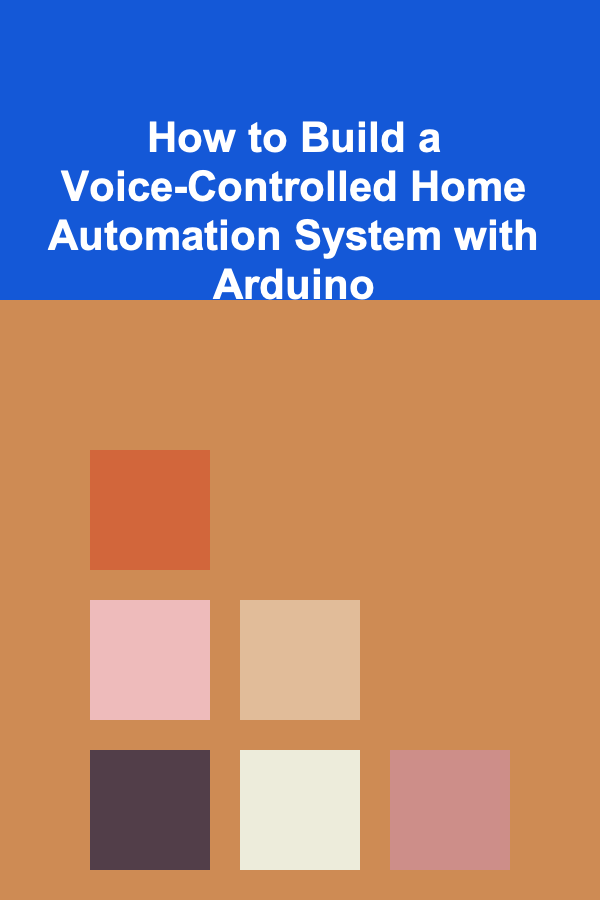
How to Build a Voice-Controlled Home Automation System with Arduino
ebook include PDF & Audio bundle (Micro Guide)
$12.99$8.99
Limited Time Offer! Order within the next:

The concept of home automation has gained immense popularity in recent years, offering convenience, security, and energy efficiency to homeowners. One of the most exciting advancements in home automation is the ability to control various devices with voice commands. With the increasing use of voice assistants like Amazon's Alexa, Google Assistant, and Apple's Siri, the idea of building a custom, voice-controlled home automation system has become increasingly feasible.
In this article, we'll explore how to build a voice-controlled home automation system using Arduino, one of the most popular and accessible platforms for DIY electronics projects. We'll cover the hardware and software components, step-by-step instructions, and even how to troubleshoot issues. By the end of this guide, you'll have the knowledge to create a fully functional voice-controlled system for your home.
Understanding Home Automation and Voice Control
Before diving into the technical aspects, it's important to understand what home automation is and how voice control fits into the bigger picture.
1.1 What is Home Automation?
Home automation refers to the use of technology to control and automate household tasks. This can include managing lighting, temperature, security systems, appliances, and entertainment systems. The goal of home automation is to increase convenience, energy efficiency, and security by remotely controlling devices or automating tasks based on predefined rules.
1.2 Role of Voice Control in Home Automation
Voice control is a hands-free way to interact with home automation systems. It allows you to control various devices using simple voice commands, making it easier to manage your home environment without needing to physically interact with switches or smartphones.
1.3 Why Arduino?
Arduino is an open-source electronics platform based on simple software and hardware. It is widely used in DIY electronics projects due to its versatility, affordability, and ease of use. For this project, we will leverage Arduino's ability to interface with sensors, relays, and communication modules to control devices such as lights, fans, and thermostats. By integrating Arduino with a voice recognition system, we can create a powerful and customizable home automation system.
Components Needed for the Project
Before starting, let's take a look at the components you'll need for building your voice-controlled home automation system:
2.1 Hardware Components
- Arduino Board (e.g., Arduino Uno or Arduino Nano)
- Relay Module (for switching devices on and off)
- Microphone Module (e.g., KY-037 or an I2S microphone)
- Bluetooth Module (e.g., HC-05 or HC-06 for communication with a smartphone or PC)
- Smartphone or PC (for running the voice recognition software)
- Power Supply (for powering the Arduino and devices)
- Jumper Wires and Breadboard
- Smart Devices (e.g., lights, fans, or other appliances you wish to control)
- Optional: Amazon Alexa or Google Assistant (for integration)
2.2 Software Components
- Arduino IDE (for programming the Arduino)
- Voice Recognition Software (e.g., Google Assistant, Amazon Alexa, or an offline voice recognition library)
- Blynk App (if using a smartphone for remote control)
- IFTTT (If This Then That) (for creating voice automation rules)
Setting Up the Hardware
Now that you have the components, it's time to begin setting up the hardware.
3.1 Wiring the Relay Module to Arduino
The relay module is essential for switching devices on and off remotely. It acts as an intermediary between the low-power Arduino and high-power appliances. Here's how to wire it:
- Connect the VCC and GND pins of the relay to the 5V and GND pins on the Arduino, respectively.
- The IN pin of the relay goes to one of the digital pins on the Arduino (e.g., Pin 7).
- The NO (Normally Open) and COM (Common) pins on the relay will be connected to your device (e.g., a lamp or fan). When the relay is activated, the circuit between these pins closes, allowing current to flow to the device.
3.2 Setting Up the Microphone Module
To give your Arduino the ability to recognize your voice commands, you'll need a microphone module. If you're using a KY-037 microphone:
- Connect the VCC pin of the microphone to the 5V pin on the Arduino.
- Connect the GND pin to the GND pin on the Arduino.
- The DO (Digital Output) pin of the microphone should be connected to one of the digital input pins on the Arduino (e.g., Pin 8).
3.3 Connecting the Bluetooth Module
For the voice recognition software to communicate with your Arduino, you need a Bluetooth module. The HC-05 or HC-06 Bluetooth modules are widely used for such projects. Here's how to connect it:
- Connect the VCC and GND pins of the Bluetooth module to the 5V and GND pins on the Arduino.
- Connect the TX pin of the Bluetooth module to the RX pin of the Arduino, and the RX pin of the Bluetooth module to the TX pin of the Arduino.
3.4 Testing the Circuit
Before moving forward with the software, it's a good idea to test your circuit. Upload a simple blink sketch to the Arduino to ensure that everything is properly connected and that the relay can switch devices on and off when triggered by the Arduino.
Software Setup for Voice Control
The core of this project is integrating voice recognition software with your Arduino. There are several ways to accomplish this, ranging from simple offline solutions to cloud-based options like Google Assistant and Amazon Alexa.
4.1 Using Google Assistant with Arduino
Google Assistant is an excellent tool for voice control, and it integrates easily with Arduino through third-party apps like IFTTT. Here's how to set it up:
-
Create an IFTTT Account:
- Sign up for IFTTT and create a new applet.
- The "This" part of the applet will be your voice command. Select Google Assistant and choose a voice command like "Turn on the lights" or "Turn off the fan".
- For the "That" part, choose Webhooks, which will send an HTTP request to your Arduino server.
-
Set Up the Arduino to Receive HTTP Requests:
- To receive HTTP requests from IFTTT, you need to set up an HTTP server on your Arduino. This can be done using an Ethernet shield or a Wi-Fi module like the ESP8266.
- Write code for the Arduino to listen for incoming HTTP requests. Based on the command (e.g., "Turn on the lights"), the Arduino will activate the corresponding relay module to control your device.
-
Test the Voice Command:
- Once everything is set up, use Google Assistant to give voice commands. IFTTT will pass the command to your Arduino, and the device will respond accordingly.
4.2 Using Amazon Alexa with Arduino
Amazon Alexa is another popular choice for voice-controlled home automation. It requires integration with the Alexa Skills Kit and Lambda functions, but it can be simplified using third-party services like Sinric Pro.
-
Set Up Sinric Pro:
- Sign up for Sinric Pro and create a new device (e.g., a smart light or fan).
- Link your Sinric Pro account with Alexa via the Alexa app.
-
Connect Alexa to Arduino:
- Use the SinricPro Arduino Library to communicate between your Arduino and Alexa. This library handles the Alexa voice commands and passes them to the Arduino to control devices.
-
Voice Command Testing:
- After the skill is set up, you can say commands like "Alexa, turn on the light" to control devices connected to the Arduino.
Programming the Arduino
To make your Arduino work with the voice control system, you need to write a program that listens for incoming commands (either through Bluetooth or HTTP requests) and takes action based on the command. Here's an example sketch:
#include <SinricPro.h>
#define RELAY_PIN 7 // Pin connected to relay module
void setup() {
pinMode(RELAY_PIN, OUTPUT); // Set the relay pin as output
Serial.begin(9600);
SinricPro.begin(); // Start Sinric Pro
}
void loop() {
SinricPro.handle(); // Handle incoming requests from Alexa
}
void turnOnLight(const String &deviceId) {
digitalWrite(RELAY_PIN, HIGH); // Turn on light
}
void turnOffLight(const String &deviceId) {
digitalWrite(RELAY_PIN, LOW); // Turn off light
}
This program listens for commands from Alexa (through Sinric Pro) and turns a light on or off by controlling the relay module.
Testing and Troubleshooting
Once everything is set up, you can test your system by issuing voice commands and observing the behavior of your devices. If something isn't working, here are some common troubleshooting steps:
- Bluetooth Connectivity: Ensure the Bluetooth module is paired with your phone or PC. If the Bluetooth connection is lost, the system won't be able to receive commands.
- Device Not Responding: Check the relay wiring and ensure it's correctly connected to the Arduino and your device.
- Voice Command Issues: Make sure the voice recognition software (IFTTT or Sinric Pro) is properly configured and that the commands are being sent to the correct URL or device.
Expanding Your System
Once you have the basic system working, you can expand it by adding more devices and integrating additional sensors (e.g., motion sensors, temperature sensors) for more advanced automation.
- Integrate Motion Sensors: Automatically turn on lights when someone enters the room.
- Smart Thermostat: Control the room temperature based on voice commands or time of day.
Conclusion
Building a voice-controlled home automation system with Arduino is an exciting project that combines electronics, software development, and home automation. With simple components like an Arduino board, relay modules, and a microphone, you can create a system that responds to voice commands, allowing you to control lights, fans, and other devices remotely. By integrating with platforms like Google Assistant or Amazon Alexa, you can make your home smarter and more efficient, all while having fun with DIY electronics.
As you continue to build and expand your system, you'll unlock even more possibilities for home automation, all controlled with the power of your voice. Happy building!
Reading More From Our Other Websites
- [Home Space Saving 101] How to Maximize Space in Your Dining Room with Space-Saving Furniture
- [Home Staging 101] How to Stage Your Home for Open Houses and Attract More Buyers
- [Home Pet Care 101] How to Keep Your Pet Comfortable During Cold Weather
- [Needle Felting Tip 101] How to Produce Life‑Like Needle‑Felted Sea Creatures with Accurate Anatomical Details
- [Home Lighting 101] How to Use Under-Cabinet Lighting in Your Kitchen
- [Personal Care Tips 101] How to Disinfect Your Toothbrush to Avoid Germs
- [Organization Tip 101] How to Use Labels to Keep Your Living Room Organized
- [Home Budget 101] How to Use the Envelope System for Better Spending Control
- [Home Family Activity 101] How to Plan a Family Painting Party at Home
- [Home Maintenance 101] How to Take Care of Your Home's Outdoor Furniture

How to Plan a Themed Party That Everyone Will Enjoy
Read More
How to Prevent Pest Infestations with Regular Home Maintenance
Read More
How to Secure Your Garage Door Against Unauthorized Access
Read More
Understanding the Impact of Mindful Spending
Read More
How to Understand the Difference Between Good and Bad Carbs
Read More
10 Tips for Improving Volleyball Serve Receive
Read MoreOther Products

How to Plan a Themed Party That Everyone Will Enjoy
Read More
How to Prevent Pest Infestations with Regular Home Maintenance
Read More
How to Secure Your Garage Door Against Unauthorized Access
Read More
Understanding the Impact of Mindful Spending
Read More
How to Understand the Difference Between Good and Bad Carbs
Read More